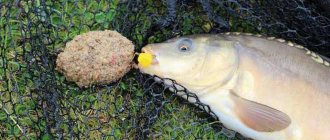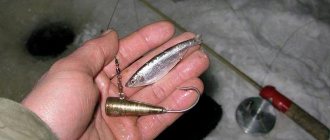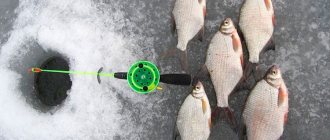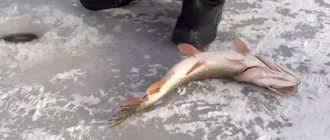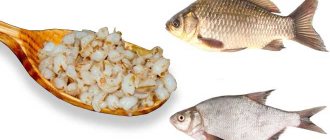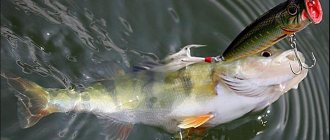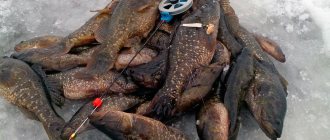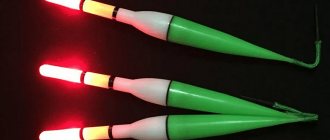Today, the issue of preparing semolina for fishing is quite relevant. After all, such a bait is in great demand among fishing enthusiasts from the carp family. Of all the well-known attachments of plant origin, it is used in combination with other components or in its pure form more often than others.
There are different types of its preparation, but the most popular are the baits made from “chatterbox”, “mastyrka” and “steep” semolina. It is used to catch virtually all non-predatory fish in fresh water, with the possible exception of silver carp.
Fishing decoy: why do fishermen prefer this bait?
It is believed that the most catchy bait is semolina. Properly cooked “semolina” allows the fish to bite the bait, but at the same time it is virtually impossible to completely rip it off the hook.
If small fish predominate in the reservoir, and the target is to catch a big one, the “semolina” will help draw its attention, and the bait itself will actively be eaten by small fish, but will not get lost until the big fish arrives.
The bite on “semolina” is much more active than with conventional baits, including such unusual ones as “bonduelle” and potatoes, when fishing for carp. More often, semolina bites from late spring until freeze-up.
In winter, “semolina” is not used; in early spring it is more advisable to use bait.
Semolina has one undeniable advantage.
Such a nozzle becomes dusty while it is in the water. In particular, such dusting is clearly visible during strong currents. Semolina creates a fairly dense bait, which is very attractive to large fish.
Semolina is sometimes used for catching carp with a feeder, making it into a large bait, with dimensions and shape very similar to a boilie. The semolina does not attach well to the hairline, but is easily put on over the hook. Due to its inherent elasticity, the hook is completely hidden when fishing on a feeder.
Semolina actually does not have its own smell, but at the same time it is perfectly aromatized with the help of dry or liquid additives. It is quite possible to mix it, not only in clean water, but also in water where liquid flavoring is added.
Many fishermen prepare dough from semolina, lumps of it are well attached to the hook.
Additives to semolina to improve the bite
With the help of additional components, semolina for fishing can easily change its consistency, taste, smell and color.
Components for viscosity
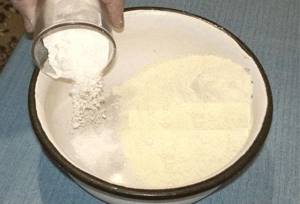
However, it is important to understand here that excessive addition of such a binder can kill the smell of semolina. This component may be needed when fishing in a strong current, if you are fishing with dough or mastyrka. But properly prepared semolina does not need such thickeners.
Flavors
There is a wide choice here. These can be either liquid or solid bulk additives. Liquids include:
- oils;
- honey;
- syrups;
- sprays.
Popular bulk products include:
- hemp;
- vanilla;
- powdered milk;
- sesame;
- various vegetable cakes, etc.
Some fishermen mix semolina with garlic and catch crucian carp quite well. This root vegetable works somewhat strangely. The fish take it very well or don’t bite at all.
What kind of fish bites on semolina?
Fishing with semolina is considered one of the non-standard and effective methods. The semolina bait is suitable for any white fish. Therefore, in the process of catching carp, crucian carp, bream or other fish, it is preferable to have it in stock. Roach, rudd, ide, and bream are also caught with it.
In particular, fish prefer semolina in winter. In the summer, the fish bite much worse. Carp are most often caught with such bait at great depths or in underwater holes. To make the bite better, a small amount of flavoring is added to it.
Having the skills to properly prepare semolina will determine how successful your fishing will be. The main thing is that the semolina should not slide off the hook.
The main advantage of this method is that the semolina under the water column is quite clearly visible and becomes limp. Seeing the bait, the fish swims up to it and swallows it whole with hooks. If the hooks are good enough and match the depth of the reservoir, then there is a high probability of catching a large fish.
How to catch semolina in winter

As you know, in winter fishing the main bait is live food (bloodworm, jig, burdock or Chernobyl larva). Nevertheless, it makes sense to fish with semolina, especially when fishing from the bottom with a hook.
Differences from summer bait
The main, and perhaps the only difference, is the size of the bait itself. The fish's appetite decreases greatly in winter, so you have to constantly look for an approach to it. A small supply of flavors often helps to find the key to the mood of the fish.
It is justified to use mastyrka or semolina dough when fishing for bream at night in a tent. Having lowered several gears into the holes at once, anglers wait for a bite. It's time to experiment with aromatics.
In winter fishing, it is very important not to overfeed the fish with bait mixture. This is especially true if fishing is done with plant baits. But adding dry semolina to the bait is possible and even necessary. The semolina particles are quite small and the fish will not be able to get enough of them.
Main types of baits
If you decide to fish for semolina, then you need to learn how to cook it. There are a certain number of recipes on how to prepare it.
Directly for the cooking process you will need:
- semolina;
- pot;
- water;
- empty matchbox;
- flavorings;
- stocking.
"Chatterbox"
Semolina “chatter” is prepared by pouring cold water .
It should be noted that the water should be at room temperature, not hot. If you cook semolina in warm water, it will be held on the hook rather weakly, therefore, such a bait will not live up to your expectations. “Chatterbox” is cooked for one fishing trip , only in advance before leaving for the fishing site in the utensils where it will be used when fishing. A 100-gram glass is quite enough for such a bait and should be enough for 3-4 hours of fishing for crucian carp with 3 fishing rods, so there is no need to pre-cook a large amount of semolina.
"Mastyrka"
In “mastyrka”, cereal is the main binding component . All widely known mixtures with this name are made on the basis of semolina. For fishing, they use both bait, which is obtained from a purchased mixture, and those welded by fishermen with their own hands.
The use of the latter is more feasible from an economic point of view. Everyone can experiment with different combinations of elements to find their own optimal composition of the “mastyrka”.
"Cool"
Despite its attractiveness as bait, hard-boiled semolina is currently used quite rarely for fishing; it is mainly used in reservoirs with large currents, where fishing rods and donks are used, since water weakly erodes boiled semolina.
Recipes for various semolina baits
A huge variety of baits are prepared from semolina according to different recipes. But, fishermen most often use only a few of them:
- Chatterbox;
- Mastyrka;
- Semolina dough.
These baits can be easily prepared at home, without special knowledge and skills, you just need to know the recipe and strictly follow it. The most catchy recipes have long been known to the fishing world and most fishermen know how to prepare semolina for fishing so that it is effective.
How to cook mash
The success of your fishing will directly depend on the correct and quality preparation of the chatterbox. In order for the bait to turn out well, you must strictly adhere to the recipe and all stages of preparation. First, prepare semolina and the required amount of water (it should be at room temperature). You also need to stock up on a glass jar with a lid, a syringe for taking the mash and a spoon.
Cooking process
- Pour a quarter can of water.
- Pour semolina into the jar until it is completely covered with water.
- Now gradually pour water into the jar, stirring the semolina until the water fills the container completely.
- Then drain off the excess water.
- Now leave the resulting mixture to infuse for 30 minutes.
Cooking features
- Pour the semolina generously while placing it in the jar, otherwise you will not get the desired consistency.
- It would be a good idea to pre-soak the cereal in water so that it absorbs the required amount of liquid.
- If there is too much water, then it should be poured out very carefully so as not to drain the cereal with it.
- In the end, you should end up with a homogeneous mass that is not too liquid, but not too thick.

Application
Most often, mash prepared according to this recipe is used for catching crucian carp; it is also actively used when fishing for other white fish. This bait can attract almost any peaceful fish to your hook. Of course, you won’t catch a silver carp with such bait, since silver carp are caught using completely different baits.
Impaling
But knowing everything about how to prepare semolina for fishing does not mean that you will be able to catch a lot of fish. You also need to have knowledge of how to put it on a hook. A prerequisite for successful fishing is hiding the hook tip under the bait. Some fishermen neglect this factor, although most often the point of the hook hides in the water itself.
Storage
A cold place is the main condition for preserving the chatterbox. Exposure to moisture, as well as direct sunlight, can have a detrimental effect on the performance of the bait. If stored incorrectly, you will have to prepare the mash again, which is not entirely good.
As a rule, a crust forms on the mash, which is the result of storage. Before fishing, you should carefully remove the crust, and only after that you can start hooking it. If the recommendations are not followed, the bait can quickly become unusable.
How to prepare mastyrka
The chatterbox is liquid, but the mastyrka is somewhat reminiscent of dough in its consistency, since it firmly holds on the hook and can easily be put on the hook without additional devices in the form of a syringe or sticks. To prepare mastyrka, you need to buy semolina and peas in advance.
Cooking process
- First you need to cook ordinary pea porridge in water.
- When the water from the porridge begins to boil away, you need to start adding semolina, stirring the entire mixture periodically.
- Add semolina until you get something similar to plasticine in consistency. If your mastyrka ends up falling apart, then you need to add a little more semolina.
- You should end up with a kind of pea plasticine that is not dry and does not fall apart in your hands during modeling.
Mastyrka has an excellent advantage over other semolina baits - the smell of peas. Peas are a good flavoring agent, and their smell attracts fish from large areas of water. Of course, you can buy Dry Blooder, but in combination with peas its effect will increase significantly.
Mastyrka can be stored much longer than the mastyrka described above. Just make a big ball, put it in a plastic bag and place it in the refrigerator. This storage method does not in any way affect the properties and quality of the bait. Fishermen very often dip the mastyrka in cotton wool so that it becomes covered with fluff, this will allow it to stay on the hook longer and more reliably.
Application
Most often, this bait is used for catching crucian carp. But other peaceful fish also respond well to it. If you also add specific flavors that this or that type of fish prefers, then such bait simply will have no equal in the pond.
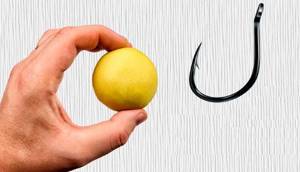
Impaling
It is very simple to attach the mastyrka to the hook. Good consistency allows you to roll a ball of mastyrka without any problems, like dough, and easily place it on a hook. You need to attach it in such a way that the ball completely covers the hook tip.
To catch fish with a mastyrka, you can use hooks of any size, since you can roll a ball of the desired diameter from it without much difficulty. Ease of use gives this bait an undeniable advantage.
Storage
If you decide to prepare the bait in advance, it is better to put it in the refrigerator until your fishing trip. The bait should not be frozen, nor should it be exposed to direct sunlight.
On a pond, it is better to place a bag or jar of mastyrka in the shade of trees or even hide it in thick grass. If you store your bait incorrectly, you may be in for some unpleasant surprises while fishing, so it’s best not to tempt fate.
How to make semolina dough
Semolina dough is not used by fishermen as often as regular mash. It is often used in reservoirs with strong and medium currents. This bait is not suitable for fishing in stagnant bodies of water, since the dough will be washed away by water for a long time.
Cooking process
- Soak semolina in water for half an hour.
- Place the soaked semolina in gauze and tie it like a bag. Do not tie the bag tightly, as the cereal will expand during cooking and needs free space.
- Now you need to immerse your bag in boiling water for five minutes.
- Now remove the bag from the water and leave it for a couple of minutes to remove excess water.
- After cooling, you need to untie the gauze, add flavorings to the dough and knead it with your hands until it becomes homogeneous.
Application
Some fishermen advise adding flour to the finished dough, they say that this way it will stay on the hook for a long time. And it’s much easier to bait a dense bait. So, we figured out the question of how to prepare semolina for fishing.
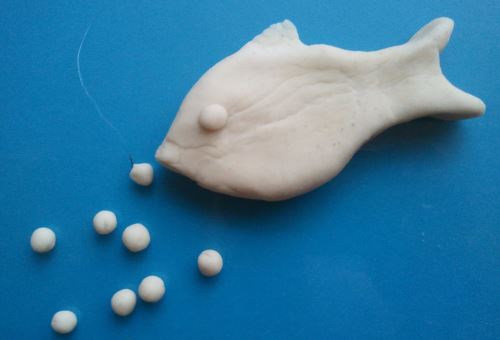
Impaling
The most convenient and profitable option is to use hard-boiled semolina for fishing for crucian carp. Coating the tip of a hook with semolina dough is quite simple, which makes putting on such a bait a convenient and enjoyable experience. This bait will stay on the hook very well during fishing.
Storage
Semolina dough should be stored in the refrigerator, after placing it in a glass container. A glass jar is convenient for getting bait from a pond while fishing. When fishing, you need to store semolina as far as possible from sunlight.
Recipe for making mash
To prepare semolina “chatter” you will need a jar in which to mix, a spoon, cereal and water (“chatter” is easy to prepare directly during the fishing process). The recipe for making a chatterbox for fishing is as follows:
- Dry cereal is poured into the prepared utensils .
- Then cold water is gradually added , the semolina is mixed until all the grains are moistened with water. If there is some liquid left on top, you need to slowly pour it out. The moistened cereal needs to brew and ripen for 30 minutes.
- After that, you need to knead the semolina with a stick until you get a homogeneous mass.
The sticky, viscous mass is baited using a small and thin wooden stick , which is easy to find along the shore of a reservoir; you just need to remember that there is no bark or dirt on the stick. The hook is held by the shank with one hand, and the other holds a strip of semolina with a stick and wraps the hook tip.
Then, holding the nozzle by the rein so that there is no contact with the ground or clothing, cast the rod. You can cast using various methods, without the fear that the bait will fall off the hook during a sharp swing, but the cast itself must certainly be accurate. If the bait does not hit the right place, it is worth throwing the rod, and the nozzle should be changed, because, having hit the water, it has become unsuitable for further fishing.
To give the mash a different flavor, the flavorings themselves, which can be various oils (sunflower, anise, hemp), various commercially available additives, vanilla and other spices, must be mixed with dry cereal before preparing the mash.
For a 100 mg batch, 3-4 drops of oil or a regular 5 gram pack of vanilla sugar will be sufficient.
If the weather is not hot and moderate and there is no drought, then you can store the chatterbox open while fishing. If it is hot or raining, then it is necessary to cover the package with semolina to prevent it from further drying out or getting wet.
If the bait dries out, a crust will appear on the top layer, which will need to be carefully removed, and under it there will again be semolina of a suitable condition. And if liquid gets into the bait, then you need to pour out the excess water and add a small amount of dry semolina on top so that the bait is suitable for further fishing.
How to put semolina on a hook
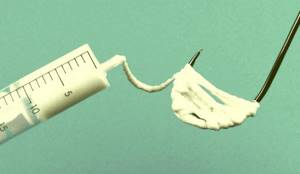
Semolina dough can be placed simply by carefully sticking it onto a hook in the form of a pellet. The size of the bait is selected based on the size of the hook, as well as the intended trophy.
Important. It happens that the fish shows itself, but refuses to take it normally. In this case, you should tie a smaller hook and stick a small ball of dough. This technique often helps, especially when the decrease in bite is not associated with a sudden change in weather.
The boilies are not pierced with a hook, but tied to the tip of the thread. Swallowing the bait, the fish pulls the hook into its mouth, without any suspicion.
Recommended reading: The best bait for roaches in winter
Mastyrka is planted in the same way as dough. If the bait turns out to be too thick and even hard, you should place the hook tip closer to the surface of the lump.
Mastyrka recipe
Components:
- Pea flour – 1 part;
- Semolina – 1 part;
- Water – 2 parts;
- Food coloring - a pinch;
- Sunflower oil – teaspoon;
- Small saucepan with lid
- Large pan where the small one will be.
The peas are placed in a pan with a non-enamel coating, filled with cold water and cooked until fully cooked over low heat, stirring from time to time and adding boiled water, if possible.
When you obtain a homogeneous pea mass, which will look like jelly in appearance, you need to add sunflower oil, remove from heat and, stirring continuously, pour in the cereal, and then let the pan cool.
When the mass has cooled, you should knead it a little with your hands and the “mastyrka” will be ready . For 200 gr. peas will need up to 150 grams. semolina and 10 ml sunflower oil. If you add too little semolina, the bait will become very soft and will not stick well to the hook, but if you add more, it will be too elastic.
To prepare such a “mastyrka” on the road, you need to buy pea flakes, which you will need to pour boiling water on top of, and then mix with butter and semolina.
It is more advisable to use “mastyrka” made from peas for catching crucian carp and carp, using a simple fishing rod or an ordinary donka. Fishing with a spring bottom should be especially successful. To catch roach or bream, you can prepare “mastyrka” from buckwheat. Alternatively, you can use “mastyrka” on corn or oats.
Some people also use potatoes for it. Various flavorings and additives are added to the finished mixture in small portions. It is better to do less than to overdo it, as the strong and strong smell can scare away the fish.
Cooking methods
There are many recipes for this plant bait. They are all quite simple, time-tested, and work well. You can prepare semolina as a topping:
- in the form of a mixture of semolina and water, without heat treatment (mash);
- dough consisting entirely of semolina or with the addition of additional components that increase the viscosity of the nozzle;
- in the form of porridge, by boiling in water;
- boilies.
Semolina chatter
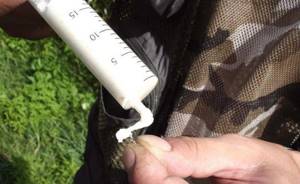
This is a kind of rubber decoy for fishing, the preparation of which will take about half an hour. You can prepare the mash as follows:
- In a suitable sized container: a jar, plate or mug, pour in cereal (about half a glass), fill it with water one to one;
- We wait 5 minutes until the cereal is saturated with water and swells a little. Stir the mixture and place it in several layers of folded gauze. Wrinkle the future bait in gauze under clean, cool tap water. The process may take 20-30 minutes, you need to achieve the consistency of soft rubber;
- When the white rubber-like mixture becomes homogeneous (the thread should break when stretched by 6-7 cm). Roll the resulting dough into a ball or place it in a syringe. It is most convenient to use a syringe with a volume of 5-10 cubic meters.
Advice. It is very difficult to draw a rather thick “dish” through the narrow neck of the syringe. Therefore, it is easier to temporarily remove its moving part (piston) and place the loose part through the freed large hole. This can be done with your fingers, gradually pushing the dough, but it is easier by suction through a narrow neck.
Semolina dough
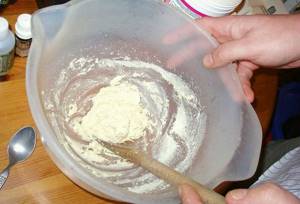
It will take less time to knead; the bait does not need to be brought to a rubber state. The nozzle is also based on two main components - semolina and water. Various additives will help diversify the taste, aroma and consistency:
- wheat or corn flour;
- ground rolled oats;
- sugar;
- honey;
- vanilla;
- anise drops;
- hemp;
- coriander;
- any flavorings suitable for catching white fish.
Semolina dough does not stay on the hook as long as chatter dough; it has a different task. Once in the water, small particles begin to fall off with a trail of fragrant turbidity. In addition to attracting fish, the bait makes it easy to fish without bait, which often attracts schools of small fish.
Semolina dough can be quickly made in the field or at home. When fishing, the simplest versions of this bait are most often prepared, consisting of cereal, water and flavoring.
Note! Coca Cola soda can be used as an unusual attractant. This drink contains a sufficient amount of sugar with flavor enhancers. The soda is simply added to the water before mixing.
Boyles
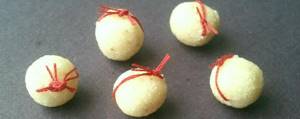
Preparation:
- A very small amount of water, literally a tablespoon, is brought to a boil.
- Add the same spoonful of semolina to boiling water and turn off the heat.
- Mix the hot mixture very thoroughly.
- As it cools, knead the mixture with your hands until it reaches the consistency of plasticine.
- A signal of readiness will be the fact that the plasticine has stopped sticking to your hands. At this stage you can add flavoring.
- The next stage is to form balls of the required size, from four millimeters for a small fish. Up to one or two centimeters in diameter for catching trophy specimens. Then we take a needle and use it to place the balls on a thread folded in half (for strength) at a distance of 5-6 cm from each other. We leave future boilies to dry hanging in a convenient dry place.
Recommended reading: How to wash bloodworms
After drying, cut the thread in the middle between the balls and tie the tails with a double strong knot. We put them in jars, where the baits are sorted by size, smell and color.
Semolina Mastyrka

This attachment usually has a medium viscosity, so it can be placed approximately between the semolina and the dough. Making mastyrka is noticeably different from the two methods already described. Preparing mastyrka involves boiling.
The main ingredients for cooking are peas, semolina, and water. Using boiled peas significantly changes the taste, smell, and color of the bait. Although various white fish respond well to this mastyrka, most of all it attracts large bream, which is very partial to peas.
On a note! To speed up the preparation of mastyrka a little, you can cook semolina in the microwave.
Contrary to popular belief among fishermen, mastyrka can be prepared not only from peas. In general, this name means any bait with the consistency of thick dough. If semolina remains an unchanged component, then other suitable products can be used instead of peas. Here are some common recipes:
Semolina with peas

Place a glass of peas in a metal bowl, fill it with water above the level of the peas, and put it on the fire. Cook over low heat, stirring constantly (so as not to burn), add water if necessary. Cook until a thick puree forms, add a spoonful of vegetable oil. While stirring, add half a glass (100 grams) of semolina and turn off the stove, leaving it to rise as it cools.
Once the mass has cooled completely, you need to rinse it well with your hands and the mastyrka can be considered ready. You can cook semolina with the addition of a small amount of boiled pearl barley or wheat to enhance the smell.
Advice . Mastyrka with peas can be slightly flavored with vanilla, however, it is very important not to overdo it with the smells.
Peas and semolina themselves have an attractive aroma that the fish can smell very well. Vanilla or other aromatics should be present only as a light spice.
With potatoes
Take boiled potatoes, rye bread and cut into small pieces. Pour a glass of pre-cooked chilled corn or oatmeal porridge. Grind this mixture in a mixer, meat grinder, or simply mash it by hand. The output should be a homogeneous thick mass. For flavor, it is advisable to add a tablespoon of sunflower oil, then mix thoroughly.
Mastyrka with sunflower seeds. A glass of sunflower seeds without peel, add dry cookies (100 grams) and pour boiling water. And also stir until a homogeneous mass is obtained.
From semolina and corn
Mix a glass of semolina with two glasses of corn grits. Pour water into a small saucepan and bring to a boil. Pour the prepared mixture into boiling water, add 3 teaspoons of sugar. Cook over low heat for 15 - 20 minutes, stirring constantly until a thick mass forms. Let it cool, knead it a little with your hands and put it in a plastic bag. You can knead a pinch of vanilla sugar into the finished mastyrka.
Recommended reading: Catching carp with peas
Recipe for making “cool” semolina
To prepare “steep” cereal, the cereal itself is moistened with water, then tied , squeezing out the water with a little effort, into a gauze knot. Such a knot is placed in boiling water, where it is cooked for up to 20 minutes , taking into account its size. The cooked semolina is released from the gauze and set aside until it has cooled completely.
Then it is used for attachment: either it is cut into cubes of the required size, or the lump is kneaded manually, and then the lumps are torn off and they begin to roll them into balls.
“Cool” semolina can be cooked with the addition of other ingredients that are attractive to fish. For example, a mixture of cottage cheese and semolina can produce an excellent catch. To prepare it you will need to stir 2 large parts of dry cereal and 1 part of cottage cheese, and then cook according to the above method. Flavorings will not be superfluous either.
It is more advisable to introduce them during the process of kneading the lump, when the semolina is already ready. You should not store “cool” semolina in a cellophane bag, since the walls of the bag may fog up and there is a risk that the nozzle will soften.
Semolina bait for fishing
In first place is semolina mash. This is the simplest and fastest attachment. Semolina chatter can be made directly while fishing. How? Read on...
Cooking time does not exceed 20 minutes. All you need is semolina and water. The minimum amount of work is to wait and interfere. Now step by step.
- Take a small container and pour in the cereal
- Add water, let stand for five minutes
- Take a teaspoon, or a stick if traveling, and mix
- Wait a few more minutes, stir again, and so on for 3-4 approaches.
- The finished mash should be viscous and stretchy
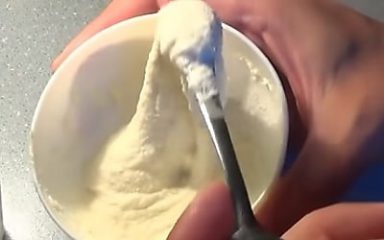
The main thing is not to overfill the water, otherwise the chatterbox for fishing will be too liquid and will not acquire a viscous consistency. For accuracy, it is better to use a tablespoon.
Proportions 1 tbsp. level spoon of cereal per 1 tbsp. spoon of water.
If desired, you can add flavoring - garlic for crucian carp, vanilla for rudd and silver bream.
Method of preparing semolina for fishing in a bag
The method of boiling semolina in a bag (cotton piece of fabric, gauze) is considered to take significantly longer to prepare semolina bait.
Take the required amount of semolina and pour it inside the pan . Afterwards, you need to pour water there so that it rises 5 cm higher than the cereal. All contents should be thoroughly mixed and left to infuse for at least 5 hours (optimally overnight).
Next, all excess water is drained, and the semolina is transferred to prepared cotton fabric , tying it with a bag. The fabric itself must be white, otherwise the cereal will be dyed.
At the next stage, water must be poured inside the pan and placed on low heat. After the water boils, a bag of semolina is placed in it . The future nozzle is cooked for 30 minutes. Depending on the cooking time, its hardness will depend.
The hot method of preparing semolina for fishing requires more time, and it is quite difficult to make a bait on a reservoir, but, on the other hand, it becomes easier to catch bream, crucian carp or carp.
Semolina gluten
To obtain gluten from semolina, no thermal treatment is required. The method is outrageously simple.
Need an old unnecessary women's :) stocking. We pour semolina into it and tie it to a water tap. We take as much cereal as we think is necessary. Turn on cold water and rinse under a gentle stream, periodically lifting and lowering the stocking with your palm. This way the semolina will be washed better.
You can do all this without stockings, with your hands. Pour water into the semolina in a plate and wait until it swells. Mix the cereal into a tight ball, and then rinse under running water.
As a result, the suspension of dust and small particles will go away with the water, and a mass resembling white rubber will remain in the stocking. This is gluten. Then we flavor it and go fishing. No one and nothing will rip such a bait off the hook.
Method of preparing semolina bait using a matchbox
Few fishermen have the skills to prepare semolina for fishing in a non-standard way to achieve good results.
First you need
to take an ordinary empty matchbox and push semolina into it as tightly as possible (you can inject some kind of flavoring into it in advance). Each box contains a variety of flavors and some cotton wool fibers.
Then the box itself needs to be closed and wrapped with thread on each side. Then put it in boiling water over low heat for about one hour When the heat treatment is completed, the nozzle should be cooled.
You will get semolina briquettes with a variety of flavors. The result will be a small bar, which is quite easy to cut into a certain number of servings.
Cutting the required sizes can be done in advance or during fishing. A nozzle prepared using this method will not be disrupted even by a very strong current.
Original Method of Making Semolina Dough | With Matchbox
Take semolina, fill a full Matchbox with it;
Then you rewind the entire box with thread. This is necessary so that under Varka it does not fall apart along with Manka;
And cook in boiling water for 1 hour.
As a result, you get an Excellent Bait for the hook, which is not so easy for the fish to pull off the hook. No tail, no scales. Try and Experiment.
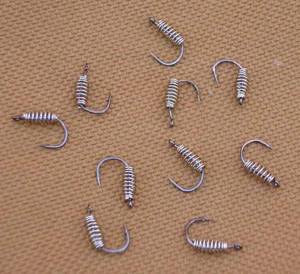
Method for preparing sweet semolina bait for long-term storage
In a small deep cup, carefully crack 2 chicken eggs . Then add up to 100 ml of sweet syrup, fruit pulp or something like that. Everything is mixed thoroughly.
Next, semolina and flour (preferably soybean) are added in equal parts. Then is kneaded . The finished mass is immediately divided into small portions and rolled into balls .
The made pellets should be placed in a strainer and placed in a pan of boiling water for a few minutes. Finally, the balls are dried on a towel, so that they can then be placed in a cellophane bag and put in the freezer .
How to prepare semolina for attachment?
First on our list is semolina. And this is no coincidence. It has truly unique properties when fishing for carp and crucian carp. But for some reason, not many fishermen use it. Most people think that it is very difficult to prepare semolina so that it stays well on the hook. But that's not true. The given recipe allows you to prepare a chatterbox that will be suitable for bottom fishing and float tackle.
- Take semolina. We pour “by eye” as much as the nozzle we need.
- Add water to the semolina so that it slightly covers the semolina on top.
- At this stage, you can add the desired flavor if necessary. It is worth noting that in most cases the smell of the semolina itself is quite enough, and excess flavorings can scare away the fish;
- The semolina is infused for 20 minutes. After this time, we begin to mix it.
You need to stir it continuously for 10-15 minutes. Moreover, if there was initially more water than needed, then at the mixing stage you can add dry semolina a pinch at a time to achieve the desired thickness. You need to stir until the semolina begins to stretch behind the spoon, creating threads 3-4 centimeters long. At this stage, grains of semolina will no longer be visible.
The longer we stir the mash, the thicker it becomes. For bottom fishing and long casts, a thicker mixture is better; for fishing from a boat, with float tackle, a more delicate one.
Fill the syringe or syringes with the finished semolina mash. If necessary, you can store such syringes filled with mash in the freezer; When fishing, we squeeze the chatter out of the syringe and wrap it around the hook.
How to prepare potatoes for bait?
Potato mastyr is often capable of attracting large fish in seemingly the most hopeless situations. Potatoes, first of all, attract carp; large crucian carp are often caught on them. Cooking potatoes is similar to making pea mash.
- We peel the potatoes and make regular mashed potatoes, only more liquid, similar to puree soup.
- Gradually add semolina to it, stirring constantly. Add semolina until the potato dough thickens and mixes poorly.
After this, let the mixture brew for 2-3 hours. As a result, we get a dense nozzle with a pleasant potato smell. Such potatoes can also be used for long casts.
How to prepare pea mastyrka for fishing?
Another very popular attachment, which is not at all difficult to prepare. Mastyrka, in other words, is pea dough. There are a ton of recipes. Here is another popular way of preparing it:
- Take shelled peas and cook simple pea porridge. Fill the peas with water to the top and cook for a couple of hours, stirring constantly. There are many ways to cook pea porridge without burning. Here everyone chooses for themselves depending on the available kitchen appliances. To prevent the peas from running away when boiling, you must first remove the foam.
- When the pea porridge is boiled and looks like thick sour cream, turn off the heat, add semolina and stir. We do this in several stages. Ultimately, semolina should cost 2 times more than ready-made pea porridge.
- The mastyrka will be ready when it becomes very difficult to stir.
- After it has cooled, knead the finished mastyrka, form it into a ball, and let it reach the desired condition for another hour or two.
This was the most classic method, and a faster way to prepare mastyrka is as follows:
- Grind the split peas in a coffee grinder to make pea flour.
- Mix the resulting flour with water until it becomes thick sour cream.
- Brew the resulting mixture for just a couple of minutes on the fire.
- Add semolina step by step and mix. We do this until the mastyrka becomes thick and it becomes difficult to mix.
- Wet our hands with vegetable oil and knead the mixture well for several minutes.
- The mastyrka turns out sticky, similar to plasticine. If you need to use it for bottom fishing with a feeder, then you should add more decoy. At the same time, the mastyrka will become denser and will stay on the hook better.
How to prepare dough from millet and semolina?
Millet is often used as bait. On our website there is even a recipe for preparing millet for bait. Not many anglers know that it can be used to make excellent bait. Properly prepared millet dough can be used for long-distance casting with a feeder and when fishing at close range. We prepare it as follows:
- Place the millet in a colander and cook it in a water bath until the grains begin to boil. In a water bath, millet does not burn and is well controlled. If we cook in the usual way in a saucepan, then we will not reach the point of complete boiling of the millet without burning it.
- After cooking, remove the colander from the water, let the water drain for a few minutes, and mash the millet with a spoon or something suitable.
- Add semolina to the millet in small portions and mix. Add semolina until the millet begins to stick together well
- We knead the millet with our hands, making balls, dipping them into the semolina and mixing again.
After the millet dough has been infused, you will get an excellent attachment. Most often, bream and other white fish take it well. At the same time, it is also worth adding millet to the bait.
